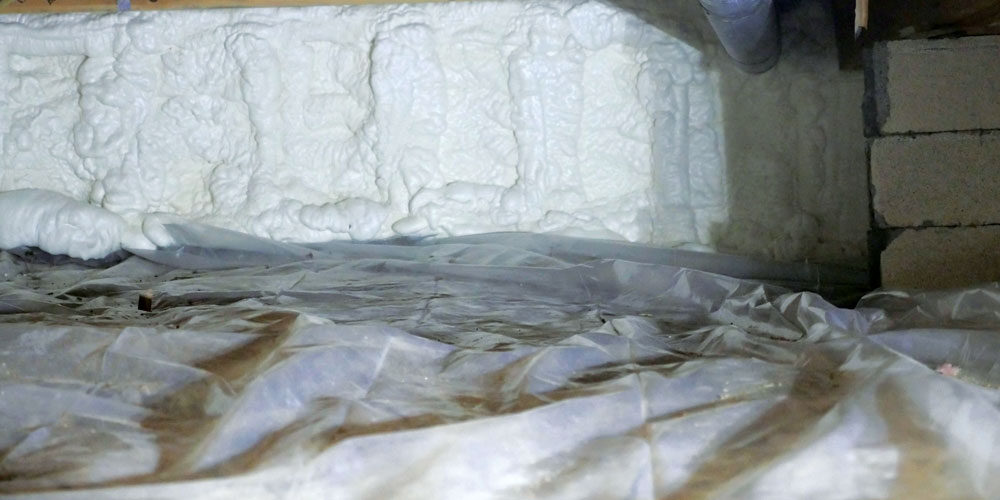What is a Vapor Barrier, and is it Needed with RetroFoam?


When researching home insulation, you’re likely to encounter many terms that you have no idea what they mean or if they are even relevant to your project.
A common question we get a lot of centers around vapor barriers and whether or not one is needed when adding RetroFoam insulation to the existing walls.
When answering this question, there’s a lot to consider, so let’s explore what a vapor barrier is and what it’s used for.
What is a Vapor Barrier?
A vapor barrier is a material that stops or slows down the movement of water vapor.
This process is also known as diffusion, which is the movement of water vapor through a structure. Vapor barriers are typically used in walls, ceilings, roofs, and foundations to help prevent issues like mold and water penetration.
Vapor Barrier vs. Vapor Retarder
Before we go any further, it’s essential to distinguish between vapor barriers and vapor retarders.
Though they serve similar purposes, they do so at different levels or classes. While a vapor barrier significantly limits water vapor movement, a vapor retarder allows some vapor to pass through but at a much slower rate.
What is the Purpose of a Vapor Barrier?
The primary purpose of a vapor barrier is to control moisture within the home.
By preventing water vapor from diffusing through building materials, vapor barriers help mitigate issues like:
- Mold Growth: Excess moisture can lead to mold, which poses health risks and can damage building materials.
- Structural Damage: Water penetration can weaken walls, ceilings, and other structural elements.
- Energy Efficiency: Controlling moisture can enhance the effectiveness of insulation, making your home more energy-efficient.
Does Insulation Need a Vapor Barrier?
A crucial point to understand is that most moisture issues can be solved by having a proper air seal.
In fact, diffusion (the process that vapor barriers address) only accounts for about one percent of water vapor penetration. This means if you have a proper air seal, you’re already solving about 99 percent of potential moisture problems.
The Importance of Air Sealing
Air sealing involves using air-impermeable building materials to establish a tight building envelope that prevents air leakage.
This approach is vital because it significantly reduces the chances of water vapor infiltrating your home.
However, this doesn’t mean the one percent managed by vapor barriers is insignificant. A vapor barrier can still be crucial, depending on your climate zone and specific home conditions.
Placement of Vapor Barriers
One complexity with vapor barriers is determining where to place them.
The general rule of thumb is that the vapor barrier should be on the warm side of your wall assembly. However, this can be tricky as seasons and temperatures change.
In regions like the Midwest, the warm side of your wall assembly can vary throughout the year, sometimes even within a single day.
HVAC Systems and Moisture Control
Given these complexities, many builders and contractors now focus on making homes as tight as possible and rely on HVAC systems to regulate humidity levels.
Modern HVAC systems can ventilate excess moisture and bring in fresh air as needed, ensuring a balanced and comfortable indoor environment.
Building Codes and Inspections
Another layer of complexity comes from building codes and inspections.
These vary by climate zone, county, and even the specific inspector working on your project. Different inspectors can have different interpretations of the code, which means there’s a lot of gray area regarding the necessity and placement of vapor barriers.
Do You Need a Vapor Barrier with RetroFoam?
If you’re using RetroFoam or another injection foam insulation for an existing wall, the good news is you likely don’t need to worry about adding a vapor barrier.
The primary advantage of products like RetroFoam is that they can be installed without tearing down walls, making the process less invasive and more efficient.
Key Takeaways
- Understand Diffusion and Air Sealing: Vapor barriers stop water vapor diffusion, but proper air sealing addresses 99 percent of moisture issues.
- Consider Your Climate and HVAC System: The need for a vapor barrier can vary based on your climate and the efficiency of your HVAC system.
- Check Local Codes: Building codes and inspections can differ, so always check local requirements.
- RetroFoam Benefits: RetroFoam can provide effective insulation for existing walls without needing additional vapor barriers, especially if your HVAC system is well-maintained.
Adding RetroFoam Insulation to Your Existing Walls
This article is just a piece of the puzzle regarding vapor barriers, moisture control, and insulation.
For more helpful information on putting all of the pieces together, check out the Learning Center on our website. There, you’ll find a ton of articles, videos, and resources on foam insulation and building science.
Related Articles
Understanding the Sources of Water Vapor in Your Home
What Causes Mold on Interior Walls and How to Stop It
Home Insulation for Extreme Climates – Best Practices for Hot and Cold Environments
About Eric Garcia
Eric brings his knowledge and training in building science, training in spray and injection foams from the manufacturers, more than eight years installing foam insulation, as well as selling and managing in the foam insulation industry. He is also BPI and Dale Carnegie certified and has taken several building science courses, including air sealing and building envelope. Eric is the Professor of Foam on our educational YouTube series Foam University. Even when Eric is off he is usually still “working” or thinking about work, but when he can get away he enjoys camping, hiking, hunting, and woodworking.



